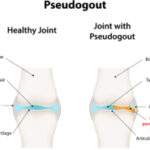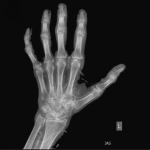Several studies have examined the role of synovial WBC count and the percentage of polymorphonuclear cells in the diagnosis of septic arthritis. A leukocyte count of >100,000 cells/mm3 is highly suggestive of septic joint (likelihood ratio [LR]: 28.0; 95% confidence interval [CI]: 12.0–66.0), and a polymorphonuclear cells percentage of at least 90% further adds to the likelihood (LR: 3.4; 95% CI: 2.8–4.2).7 The decision to halt antibiotics in light of negative cultures ultimately comes down to clinical judgment, but the presence of persistently negative cultures should clue the clinician in to an alternate diagnosis.6
In our case, antibiotics were continued after our patient’s initial presentation despite repeated negative cultures and synovial tissue sampling with no bacteria noted. Because no crystals were seen on microscopy and diagnostic uncertainty remained, the decision was made to treat for septic arthritis given its significant morbidity and mortality. What may have given an infectious etiology more credence was the purulent material noted during the first joint washout and the patient’s immunosuppressed state. However, it’s important to note the possibilityof nonbacterial causes for such a finding, as previously described in leukemia and parvovirus-associated pseudosepsis.6
A patient’s promising response to washout and antibiotics is also unreliable as confirmation for an infected joint as occurred in this case. Improvement following antibiotics may be due to their general anti-inflammatory effect rather than their antimicrobial effects.6
The patient’s new symptoms on the contralateral side approximately 2.5 months into his hospitalization were compellingly similar to his initial presentation, leading us to believe that CPPD arthropathy was responsible for both instances of his biphasic course. Notably, many observers may have initially overlooked the presence of calcium pyrophosphate crystals, requiring further analysis. The EULAR (the European Alliance of Associations for Rheumatology) highlights that proper training is crucial for the identification of crystals—even one or a few crystals are clinically significant.8 The absence of chondrocalcinosis on the patient’s right knee is also unreliable as this radiologic finding lacks sensitivity and specificity.8
• Pseudosepsis is an inflammatory arthritis with sterile synovial gram stain and culture that cannot be differentiated from septic arthritis on the basis of history, clinical presentation or serum lab values.
• CPPD has been known to mimic several types of arthritis and systemic conditions due to its varying clinical phenotypes, often resulting in delayed correct diagnosis and inappropriate or over treatment.
• Although a synovial leukocyte count of >100,000 cells/mL is highly suggestive of a septic joint, this does not rule out the diagnosis of a crystalline disease. The presence of persistently sterile cultures should clue the clinician in to an alternate diagnosis.
Conclusion
This case adds to the many atypical presentations described across the CPPD continuum and highlights the importance of early entertainment of its possibility to avoid unnecessary harm. Our patient remained in the hospital for presumed septic arthritis, which increased his risk for hospital-associated complications that resulted in increased morbidity.


